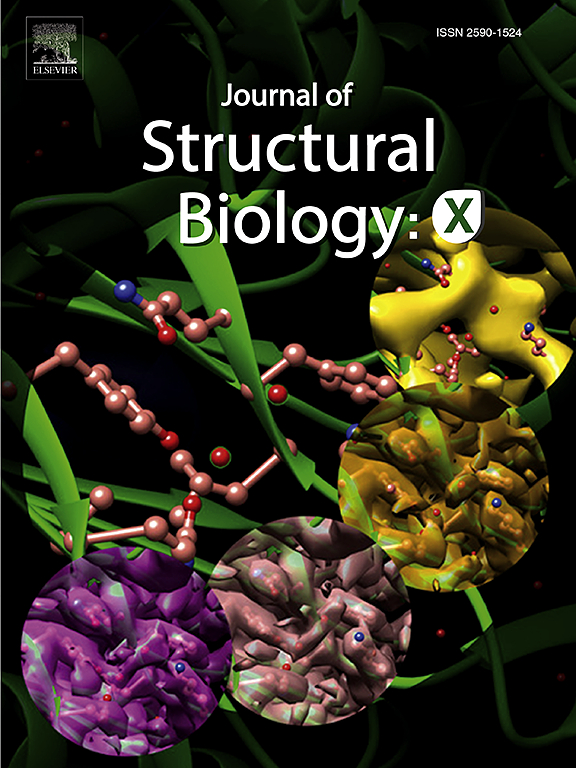Crystal structure, enzymatic and thermodynamic properties of the Thermus thermophilus phage Tt72 lytic endopeptidase with unique structural signatures of thermal adaptation
IF 2.7
3区 生物学
Q3 BIOCHEMISTRY & MOLECULAR BIOLOGY
引用次数: 0
Abstract
We presents the discovery and molecular characterization of a novel lytic enzyme from the extremophilic Thermus thermophilus MAT72 phage vB_Tt72. The protein of 346-aa (MW = 39,705) functions as phage vB_Tt72 endolysin and shows low sequence identity (<37 %) to members of M23 family of peptidoglycan hydrolases, except for two uncharacterized endopeptidases of T. thermophilus phages: φYS40 (87 %) and φTMA (88 %). The enzyme exhibits lytic activity mainly against bacteria of the genus Thermus and, to a lesser extent, against other Gram-negative and Gram-positive bacteria. The protein is monomeric in solution and is highly thermostable (Tm = 98.3 °C). It retains ∼ 50 % of its lytic activity after 90 min of incubation at 99 °C. Crystallographic analysis, at 2.2 Å resolution, revealed a fold characteristic of M23 metallopeptidases, accounting for 40 % of the structure. The remaining parts of the molecule are folded in a manner that was previously undescribed. The M23 fold contains a Zn2+ ion coordinated by a conserved His-Asp-His triad, and two conserved His residues essential for catalysis. The active site is occupied by a phosphate or a sulfate anion, while the substrate-binding groove contains a ligand, which is a fragment of E. coli peptidoglycan. The common sequence-based criteria failed to identify the protein as (hyper)thermophilic. It is likely that the protein’s thermal stability is owed to peculiar features of its three-dimensional structure. Instead of trimmed surface loops, observed in many thermostable proteins, the catalytic domain contains two long loops that interlace and form an α-helical bundle with its own hydrophobic core.

具有独特热适应结构特征的嗜热热菌噬菌体Tt72裂解内肽酶的晶体结构、酶学和热力学性质
我们从嗜热嗜热菌MAT72噬菌体vB_Tt72中发现了一种新的裂解酶并进行了分子表征。346-aa蛋白(MW = 39,705)具有噬菌体vB_Tt72内溶素的功能,与M23肽聚糖水解酶家族成员具有较低的序列同源性(< 37%),除了T. thermophilus噬菌体的两个未鉴定的内肽酶:φYS40(87%)和φTMA(88%)。该酶主要对热菌属细菌表现出裂解活性,对其他革兰氏阴性和革兰氏阳性细菌也表现出较小程度的裂解活性。该蛋白在溶液中为单体,具有很高的热稳定性(Tm = 98.3°C)。在99°C下孵育90分钟后,其裂解活性仍保持~ 50%。在2.2 Å分辨率下,晶体学分析揭示了M23金属肽酶的折叠特征,占结构的40%。分子的其余部分以先前描述的方式折叠。M23折叠包含一个由保守的His- asp -His三联体配位的Zn2+离子和两个催化必需的保守His残基。活性位点被磷酸盐或硫酸盐阴离子占据,而底物结合槽含有配体,该配体是大肠杆菌肽聚糖的片段。常见的基于序列的标准未能将该蛋白鉴定为(超)嗜热性。这种蛋白质的热稳定性很可能是由于其三维结构的特殊特征。与在许多耐热蛋白中观察到的修剪表面环不同,催化结构域包含两个长环,它们相互交错,形成具有自身疏水核心的α-螺旋束。
本文章由计算机程序翻译,如有差异,请以英文原文为准。
求助全文
约1分钟内获得全文
求助全文
来源期刊

Journal of structural biology
生物-生化与分子生物学
CiteScore
6.30
自引率
3.30%
发文量
88
审稿时长
65 days
期刊介绍:
Journal of Structural Biology (JSB) has an open access mirror journal, the Journal of Structural Biology: X (JSBX), sharing the same aims and scope, editorial team, submission system and rigorous peer review. Since both journals share the same editorial system, you may submit your manuscript via either journal homepage. You will be prompted during submission (and revision) to choose in which to publish your article. The editors and reviewers are not aware of the choice you made until the article has been published online. JSB and JSBX publish papers dealing with the structural analysis of living material at every level of organization by all methods that lead to an understanding of biological function in terms of molecular and supermolecular structure.
Techniques covered include:
• Light microscopy including confocal microscopy
• All types of electron microscopy
• X-ray diffraction
• Nuclear magnetic resonance
• Scanning force microscopy, scanning probe microscopy, and tunneling microscopy
• Digital image processing
• Computational insights into structure
 求助内容:
求助内容: 应助结果提醒方式:
应助结果提醒方式:


